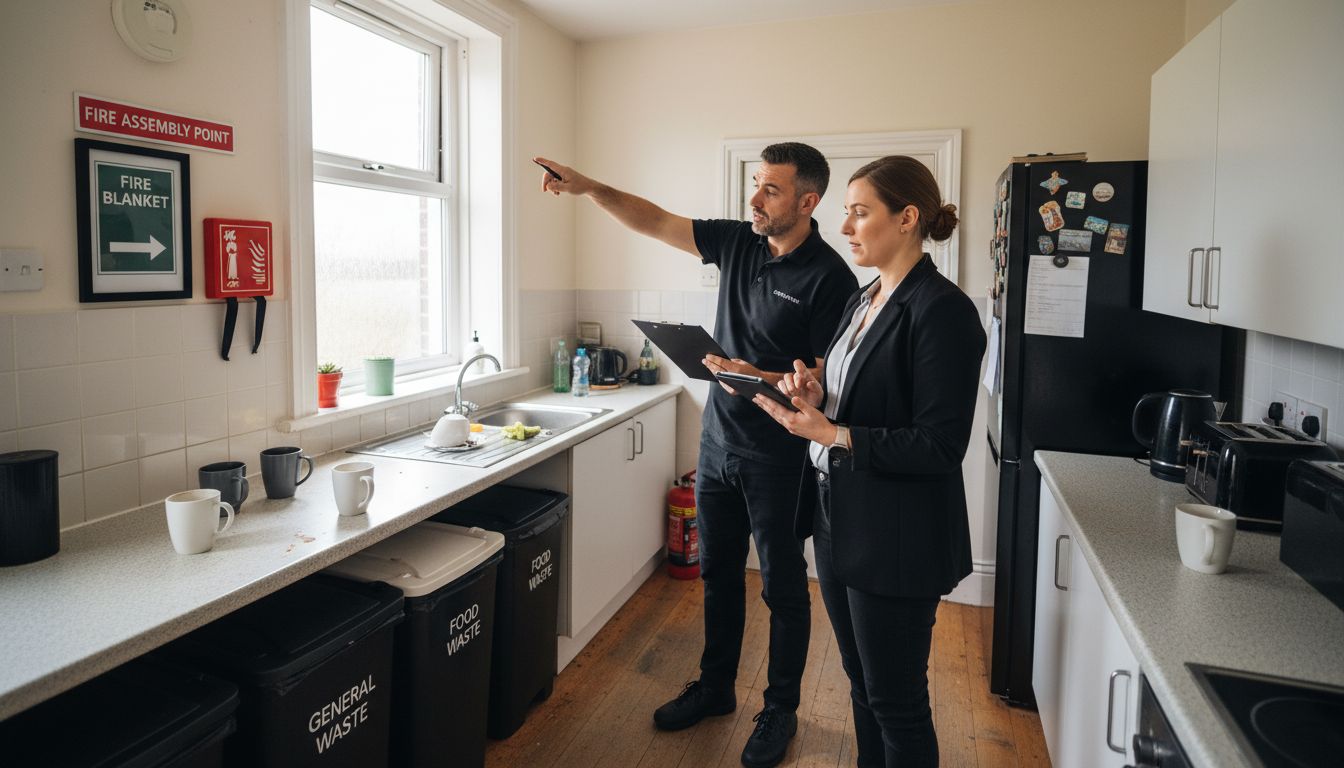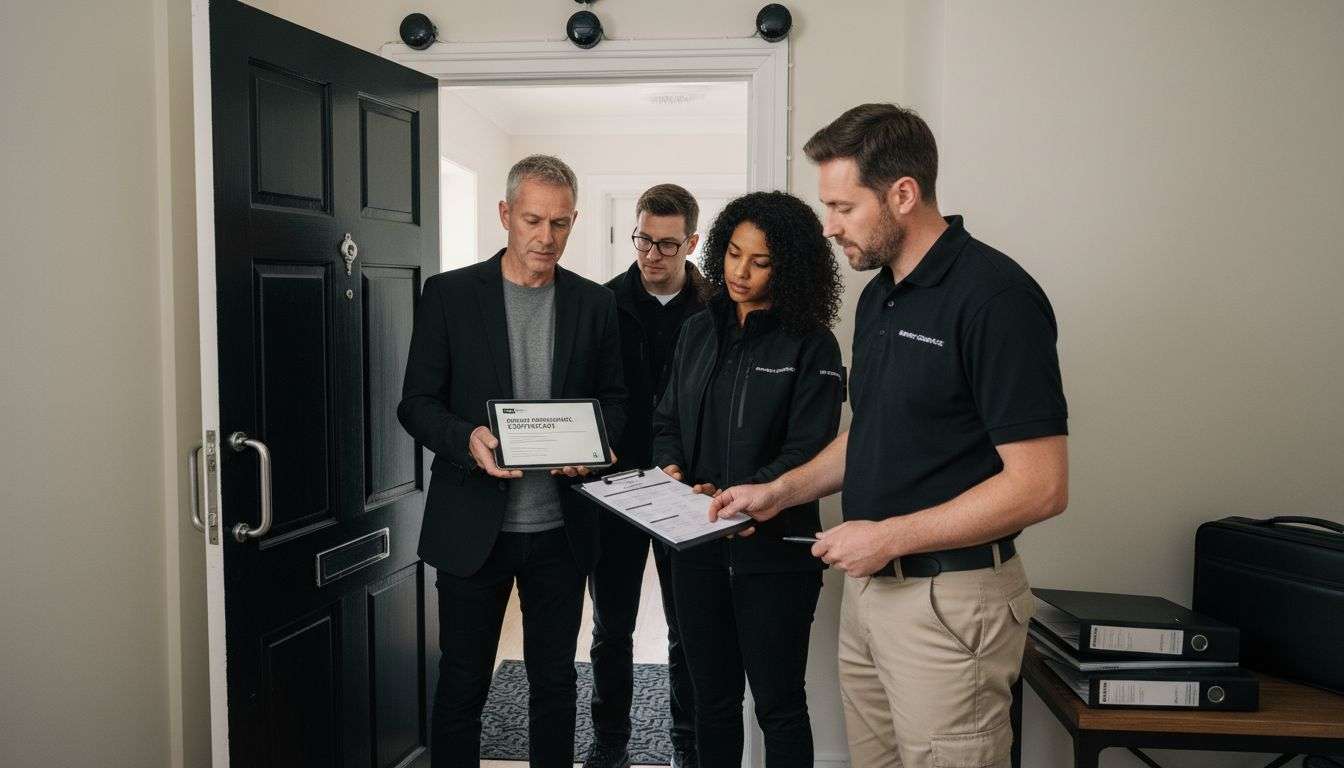Did you know that failing to comply with HMO regulations can lead to fines of up to £30,000 per offence? Managing a House in Multiple Occupation in the UK means meeting strict legal standards that protect both landlords and tenants. Understanding these essential steps helps property owners avoid costly mistakes while creating safer, better-equipped homes for residents.
Quick Summary
| Key Point | Explanation |
|---|---|
| 1. Confirm if HMO licensing is required | Check if your property houses five or more people from two or more households to determine if licensing applies. |
| 2. Conduct thorough fire safety assessments | Regularly evaluate escape routes, fire doors, and detection systems to ensure compliance and tenant safety. |
| 3. Maintain accurate tenant documentation | Keep comprehensive records of tenants and ensure occupancy limits are not exceeded to avoid legal penalties. |
| 4. Inspect communal areas and amenities | Regularly check shared spaces and facilities to ensure they meet safety standards and are well maintained. |
| 5. Establish ongoing management protocols | Develop a maintenance schedule and communication system to ensure timely repairs and uphold property standards. |
![]() |
|
Step 1: Review mandatory HMO licensing requirements
Understanding mandatory HMO licensing requirements is crucial for property investors and landlords to ensure legal compliance and property management standards. In this step, you will learn the key criteria that determine whether your property requires mandatory licensing and what that entails.
According to gov.uk, mandatory HMO licensing in England applies specifically to properties that meet critical occupancy conditions. The primary requirement is that the property must house five or more people from two or more separate households, regardless of the number of storeys. This licensing system exists to prevent overcrowding and ensure properties meet essential health and safety standards.
To effectively review your property’s licensing requirements, follow these key steps:
- Confirm total number of occupants in your property
- Verify how many separate households are represented
- Check the property’s physical configuration and number of storeys
- Determine if your specific local authority has additional licensing criteria
Warning: Failing to obtain the correct HMO license can result in significant legal penalties, including potential fines and restrictions on renting your property. Always confirm your specific local requirements, as regulations can vary between different UK regions.
For more comprehensive guidance on navigating the complexities of HMO licensing, check out our guide on HMO licensing process.
Step 2: Evaluate fire safety and property standards
In this crucial step, you will learn how to systematically assess and ensure fire safety standards for your House in Multiple Occupation (HMO) property. Thorough evaluation is essential to protect occupants and maintain legal compliance.
According to firerisk.io, HMOs inherently face higher fire risks due to shared facilities and multiple occupants. Your comprehensive fire safety assessment should focus on several key areas. First, examine the escape routes ensuring they are protected and unobstructed. Next, verify that fire doors are properly installed and functioning. Check that fire detection systems are comprehensive and strategically placed throughout the property.
Key evaluation criteria include:
- Confirm 30minute fire resistant doors are installed
- Assess fire detection and alarm systems
- Check emergency lighting functionality
- Verify clear and accessible escape routes
- Ensure fire extinguishers are appropriately placed and maintained
Warning: Inadequate fire safety measures can result in severe legal consequences and potentially life threatening situations. Always prioritise thorough and regular assessments.
For more detailed guidance on navigating HMO fire safety requirements, explore our guide on fire safety regulations to ensure comprehensive property protection.
Step 3: Check tenant documentation and occupancy limits
Verifying tenant documentation and occupancy limits is a critical step in maintaining legal compliance for your House in Multiple Occupation (HMO) property. In this section, you will learn how to systematically review and manage tenant records to ensure you meet regulatory requirements.
According to gov.uk, landlords must ensure that HMOs are not overcrowded and that the number of occupants does not exceed the permitted limit. This means maintaining comprehensive and accurate tenant documentation is essential for demonstrating compliance with licensing conditions.
Key steps for checking tenant documentation and occupancy limits include:
- Create a detailed occupancy log tracking each tenant
- Verify total number of occupants against licensed capacity
- Collect and securely store individual tenant agreements
- Confirm each tenant meets residency requirements
- Regularly update tenant records and contact information
Pro Tip: Develop a systematic filing system for tenant documents. Digital cloud storage with encrypted backups provides a secure and accessible method for maintaining these critical records.
Warning: Exceeding occupancy limits or failing to maintain proper documentation can result in significant legal penalties and potential loss of your HMO license.
To streamline your compliance process, explore our HMO compliance checklist for additional guidance on managing tenant documentation effectively.
Step 4: Inspect amenities and communal area compliance
Inspecting amenities and communal areas is a critical component of maintaining a compliant and safe House in Multiple Occupation (HMO). This step will guide you through a comprehensive assessment of your property’s shared spaces and essential facilities.
According to Elmbridge Council, HMOs must provide adequate amenities, including sufficient kitchen and bathroom facilities proportionate to the number of occupants. The communal areas should be maintained in good repair and kept clean to ensure a safe and comfortable living environment.
Key inspection criteria for amenities and communal areas include:
- Verify kitchen facilities can accommodate all occupants
- Check bathroom availability and cleanliness
- Assess overall condition of shared spaces
- Ensure proper waste management facilities
- Confirm adequate lighting and ventilation in communal areas

Pro Tip: Create a standardized inspection checklist with photographic documentation to track the condition of amenities and communal spaces over time. This approach provides a clear record of maintenance and improvements.
Warning: Failing to maintain proper amenities and communal areas can result in licensing violations and potential health and safety risks for your tenants.
For a more detailed breakdown of compliance requirements, review our HMO inspection guide to ensure you cover all critical aspects of property assessment.
Step 5: Verify ongoing management and maintenance procedures
Effective HMO management requires a systematic approach to maintaining property standards and ensuring tenant safety. This step will guide you through establishing and verifying robust management and maintenance protocols for your House in Multiple Occupation (HMO).
According to gov.uk, landlords must implement proper management practices, including regular property maintenance, prompt repairs, and ensuring all safety equipment remains fully functional. This proactive approach is crucial for maintaining high housing standards and protecting tenant welfare.
Key ongoing management and maintenance procedures include:
- Develop a comprehensive maintenance schedule
- Create a systematic repair request tracking system
- Conduct quarterly property condition assessments
- Maintain detailed maintenance and repair records
- Establish clear communication channels with tenants
Pro Tip: Implement a digital maintenance management system that allows tenants to log repair requests electronically and enables you to track and prioritize maintenance tasks efficiently.
Warning: Inconsistent maintenance and poor management can lead to potential licensing violations, tenant dissatisfaction, and potential legal challenges.
For a comprehensive overview of HMO management best practices, explore our HMO compliance checklist to ensure you cover all critical aspects of property management.
Take Control of Your HMO Compliance with Expert Support
Navigating the complex requirements of HMO compliance can be overwhelming, especially when it comes to mandatory licensing, fire safety, tenant documentation, and ongoing property management. You need clear guidance and reliable solutions to avoid costly penalties and protect your investment. Our step-by-step approach in the article highlights key pain points like ensuring correct occupancy limits, maintaining fire safety standards, and managing communal areas effectively.
Don’t let compliance challenges hold you back. Discover how AgentHMO connects you with trusted professionals who specialise in HMO sales, letting, and management across the UK. From expert estate agents to property managers well-versed in licensing and safety regulations, our platform empowers you to meet every compliance obligation with confidence. Take the next step now by visiting AgentHMO’s homepage and explore tailored services and tools that make your HMO journey smoother and more successful.
Frequently Asked Questions
What criteria determine if my property needs HMO licensing?
To determine if your property requires HMO licensing, verify that it houses five or more occupants from two or more separate households. Confirm the total number of occupants and the configuration of the property to ensure compliance with licensing standards.
How can I assess fire safety in my HMO property?
To assess fire safety, check that escape routes are clear, verify that fire doors are installed, and ensure fire detection systems are working properly. Conduct a thorough fire safety evaluation at least once a year to identify and rectify any potential hazards.
What steps should I take to ensure my tenant documentation is complete?
Ensure tenant documentation is complete by creating a detailed occupancy log and securely storing tenant agreements. Review and update tenant records regularly, aiming to maintain accurate records for all occupants to meet legal compliance.
How do I inspect amenities and communal areas in my HMO?
Inspect amenities by verifying that kitchen and bathroom facilities meet the needs of your tenants, and assess the condition of communal areas like hallways and lounges. Conduct these inspections quarterly to maintain safety and compliance standards.
What ongoing management practices should I implement for my HMO?
Establish a comprehensive maintenance schedule that includes quarterly property assessments and a systematic repair request tracking system. Implement these practices to address maintenance issues promptly and ensure tenant satisfaction, thereby reducing potential legal risks.
How often should I review my property’s HMO compliance status?
Review your property’s HMO compliance status at least every six months or whenever there are significant tenant changes or renovations. Regular checks help ensure ongoing adherence to all licensing and safety regulations.



